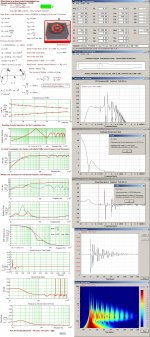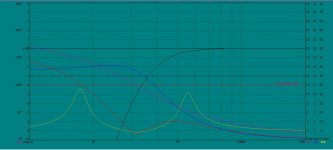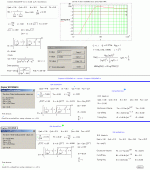Hi,Understood..I saw those Xplods at walmart, any good?
No.
FYI: Due to the T/S,IMO a 'musical' sub using the Dayton_RSS265HF-4 is when using a lower Qtc and aclosed design(<0.6) but if the driver ever is ported:
b
Attachments
LOL love the added 'belongs in a car' remark of the Xplod
An externally hosted image should be here but it was not working when we last tested it.
Hi,
No.
FYI: Due to the T/S,IMO a 'musical' sub using the Dayton_RSS265HF-4 is when using a lower Qtc and aclosed design(<0.6) but if the driver ever is ported:
b
I know this driver is best suited for an ported box. The HO version is good for sealed. I got this driver for $55 on ebay from Parts Express scratch n dent items. It was previously mounted.
I decided to go bigger than the .6 to 1.1
Here is the Dayton RSS265HO-4 in a 0.5 cu ft vented box tuned to 32 Hz. The input here is 240 watts. Clearly, excursion is exceeded below 20 Hz, so a subsonic filter with a steep cut off is a good idea here. I think PE says that this driver is designed for small boxes and it indeed does seem to perform well in one. Maximum SPL is almost 107 dB at 240 watts input, in the simulator anyway.
Attachments
Here is the Dayton RSS265HO-4 in a 0.5 cu ft vented box tuned to 32 Hz. The input here is 240 watts. Clearly, excursion is exceeded below 20 Hz, so a subsonic filter with a steep cut off is a good idea here. I think PE says that this driver is designed for small boxes and it indeed does seem to perform well in one. Maximum SPL is almost 107 dB at 240 watts input, in the simulator anyway.
I'm interested in a strong 40-50hz... Hi-Q basicly. I dont ever want to hear 20hz out of this box.
I'm interested in a strong 40-50hz... Hi-Q basicly. I dont ever want to hear 20hz out of this box.
I think this combination is a good for a really small system, like the one we have in Sweden in our summer house. I just need to drag all the bits over there... sigh...
Hi,
just stick it into an ~ 1 to 1.5 cuft sealed box. Port tunings need to be very
low for decent transient response and low response is not needed here.
Optionally use an amp with with circa 40Hz bass boost built in.
rgds, sreten.
The vented sims at the start of this thread will sound horrible.
just stick it into an ~ 1 to 1.5 cuft sealed box. Port tunings need to be very
low for decent transient response and low response is not needed here.
Optionally use an amp with with circa 40Hz bass boost built in.
rgds, sreten.
The vented sims at the start of this thread will sound horrible.
A ported speaker has a resonance (albeit, damped). Any input - including cars driving by on the street outside - will stimulate that resonance and so once you have the ported box in your room, you have it's coloration forever.
An EQ bass boost is not a resonance, just a boost on signal present in the music.
The curves in simulation programs never say "this part of the curve is from speaker motion and this part is from resonance."
Eyeballing pretty curves from speaker simulation programs tells you nothing about this.
Ben
An EQ bass boost is not a resonance, just a boost on signal present in the music.
The curves in simulation programs never say "this part of the curve is from speaker motion and this part is from resonance."
Eyeballing pretty curves from speaker simulation programs tells you nothing about this.
Ben
Last edited:
A ported speaker has a resonance (albeit, damped). Any input - including cars driving by on the street outside - will stimulate that resonance and so once you have the ported box in your room, you have it's coloration forever.
An EQ bass boost is not a resonance, just a boost on signal present in the music.
The curves in simulation programs never say "this part of the curve is from speaker motion and this part is from resonance."
Eyeballing pretty curves from speaker simulation programs tells you nothing about this.
Ben
Hi, No, No, and No. No. ?. Indeed they don't as its irrelevant. rgds, sreten.
huh...
resonance?? To quote one of my favorite movies "You keep using that word. I do not think it means what you think it means." The Princess Bride
A ported speaker has a resonance (albeit, damped). Any input - including cars driving by on the street outside - will stimulate that resonance and so once you have the ported box in your room, you have it's coloration forever.
An EQ bass boost is not a resonance, just a boost on signal present in the music.
The curves in simulation programs never say "this part of the curve is from speaker motion and this part is from resonance."
Eyeballing pretty curves from speaker simulation programs tells you nothing about this.
Ben
resonance?? To quote one of my favorite movies "You keep using that word. I do not think it means what you think it means." The Princess Bride
I use the term "resonance" kind of like Helmholtz did.
B.
Hi,
Not in the way he meant, or the way the term actually means.
Your observations of vented boxes are essentially incorrect.
rgds, sreten.
..I know this driver is best suited for an ported box. The HO version is good for sealed.
Hi, I totally disagree with your statement.
 Should be the other way around.
Should be the other way around.b
Attachments
Hi,
Not in the way he meant, or the way the term actually means.
Your observations of vented boxes are essentially incorrect.
rgds, sreten.
Naturally. I would never quibble with a definitive pronouncement from a recognized authority such as yourself. But would it be too much trouble to explain what you happen to be talking about for us little people?
Ben
A ported speaker has a resonance (albeit, damped). Any input - including cars driving by on the street outside - will stimulate that resonance and so once you have the ported box in your room, you have it's coloration forever.
the Helmholtz resonance of a port + box volume will not be excited by external sounds unless they are insanely loud, so loud you will never hear the box ringing
EQ bass boost is not a resonance, just a boost on signal present in the music.
ok... targeted signal boost.
The curves in simulation programs never say "this part of the curve is from speaker motion and this part is from resonance."
Actually, the port output/gain in simulations shows the excitation of the Helmholtz resonator (port/neck resistance + box volume) at each frequency.
Eyeballing pretty curves from speaker simulation programs tells you nothing about this.
Ben
yes it does. it's called port output/gain. The Q of the resonator can be calculated and modified by looking at the port output and adjusting the tuning variables.
edit: i should explane Q. I try to tune my BR to have a port Q of .5 which is critically damped, meaning that it does not ring. Most high Q ported subs, like most car subwoofers, have ports that are under damped therefor they boom or ring at the resonance frequency of the resonator, just like a speaker in freespace at Fs. reference: http://en.wikipedia.org/wiki/Q_factor
Last edited:
OK.... thanks for the lesson about Q.
Also, I am delighted to learn that is not beyond human ingenuity to separate one source of sound power from another such as by assessing port output in isolation. Never the less, as I said, the total output curve (so prettily drawn by the simulation program) does not tell you whether BR sound is coming from the speaker or resonating out the port and interacting (in a complex temporal and spatial way that can be quite screwy in your living room*) with each other's outputs.
But back to resonant boxes.
With BR, you are introducing and trafficking in resonances, even when they are kind of damped enough not to ring (but also not so puny they don't make that audible bump on the simulation curves... which might be quite audible). Can't have it both ways or rather, can't have it one way without the other.
Ben
*And that's without even mentioning the acoustically disgusting conditions that take place below the box resonance range.
Also, I am delighted to learn that is not beyond human ingenuity to separate one source of sound power from another such as by assessing port output in isolation. Never the less, as I said, the total output curve (so prettily drawn by the simulation program) does not tell you whether BR sound is coming from the speaker or resonating out the port and interacting (in a complex temporal and spatial way that can be quite screwy in your living room*) with each other's outputs.
But back to resonant boxes.
With BR, you are introducing and trafficking in resonances, even when they are kind of damped enough not to ring (but also not so puny they don't make that audible bump on the simulation curves... which might be quite audible). Can't have it both ways or rather, can't have it one way without the other.
Ben
*And that's without even mentioning the acoustically disgusting conditions that take place below the box resonance range.
Last edited:
- Status
- This old topic is closed. If you want to reopen this topic, contact a moderator using the "Report Post" button.
- Home
- Loudspeakers
- Subwoofers
- Musical Subwoofer.... ported or sealed?


